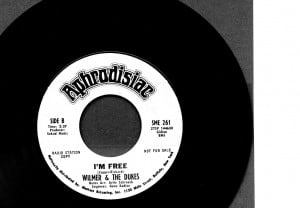45s, B-sides, and Albums
By John Marks, Curator of Collections and Exhibits
Alice Askins wrote about live music in Geneva in the 1960s . As she pointed out, most groups played the hits of the day. If you wanted to hear the real thing, you bought the record.

45 by Geneva band Wilmer and the Dukes
In the 1960s, “record” usually meant a 45 rpm with two songs, one on the A side and one on the B side. The popular song, or what the company hoped would become popular, was on the A side. The B side might be a song with potential to catch on or might just be a “throw-away” to take up the side. The Grammy Awards still recognize “record” as one song or a single track.
45s worked well for everyone. They were small and cheap to produce, only holding a few minutes of music per side. For retailers, they didn’t take up much space and probably had a decent markup. Kids – the primary market for singles – could afford them and they got the song they wanted without buying an album.
Records don’t appear as a business category in the Geneva city directory until 1973. My guess is that selling records was so commonplace, not rare, that it didn’t need a category. In the 1960s there was one business by name that sold them. Geneva Coin and Record Shop was at 395 Exchange Street and was owned by Charles Ellis. Locally known as “Tilly,” Mr. Ellis sold coins and stamps to collectors but also carried 45s and would order albums.
Geneva Coin Stamp and Record Exchange in lower right hand corner, 1974

Geneva Coin Stamp and Record Exchange in lower right hand corner, 1974
The closest directory category to Records was Musical Merchandise. Bolin Music House at 551 Exchange Street was listed here. They sold pianos, music books, sheet music, and records. Then there were the stores where people knew they could buy records. Cass Radio and TV carried them, as did many appliance stores. I grew up in Penn Yan with Bush’s House of Music. Like Cass, Mr. Bush sold radios, TVs, record players, and a lot of records. He also sold washers, dryers, refrigerators, and stoves, all in a store that was maybe 30 feet wide by 100 feet deep. You didn’t have to walk for miles as you do in today’s big box stores, in fact you couldn’t walk because the store was too full of stuff.
Every discount or department store had a music section. Family Bargain Center, Woolworth, W.T. Grant, Neisners, and Montgomery Ward all carried 45s. Since their companies ordered thousands of records, their prices were lower than locally owned stores. Other places such as drug stores sold them as well, since a few hundred records didn’t take up much space.
Change never happens overnight. Albums and 45s co-existed for a long time. The single helped sell the album and people would often buy both. Beginning in 1967 with the Beatles’ Sgt. Pepper’s Lonely Hearts Club Band, albums became more of a whole concept. People wanted to hear the whole album and hear how the songs worked together. Album-oriented rock (AOR) radio stations would play “deep cuts” that hadn’t been promoted as singles by the record company.
I was surprised to learn that 45s were made until 1989, and modern turntables still come with 45 rpm settings. After 1989, companies made cassette tape singles and CD singles, but it wasn’t the same and both ideas failed.
Thanks to Mikel George, owner of Area Records and Music, for inspiring this topic and supplying additional information.

I’ve found a number of 45’s in the attic of an old house I bought. I was curious about one in particular: “Blinded by the Light” by Springsteen with “Starbird No. 2” by Mnfred Mann’s Earth Band on the B side. I know there was a relationship between M. M’s Earth Band and Springsteen, but I’ve never seen anything like this. It has some scratches, and someone wrote “2 inside 50” (no cent sign on keyboard) cents. I was wondering what its value may be?
Unfortunately we don’t have the expertise to help with valuation. It’s also considered unethical for museums to value items they might collect. You could try a local used record shop. Here in the Finger Lakes region one is The Record Archive in Rochester. You might also find information through collector websites or Ebay. Good luck!